×
The Standard e-Paper
Join Thousands Daily

The economy generated 816,600 jobs in 2022, a 4.45 per cent jump from the previous year, handing former President Uhuru Kenyatta's regime a significant annual performance in his last year in office.
The economy's job creation momentum under the Uhuru regime during his final year in office however slowed down from two years earlier, when jobs under his government grew by 924,900 or 5.31 per cent between 2020 and 2021 on economic recovery following the drop in Covid-19 numbers.